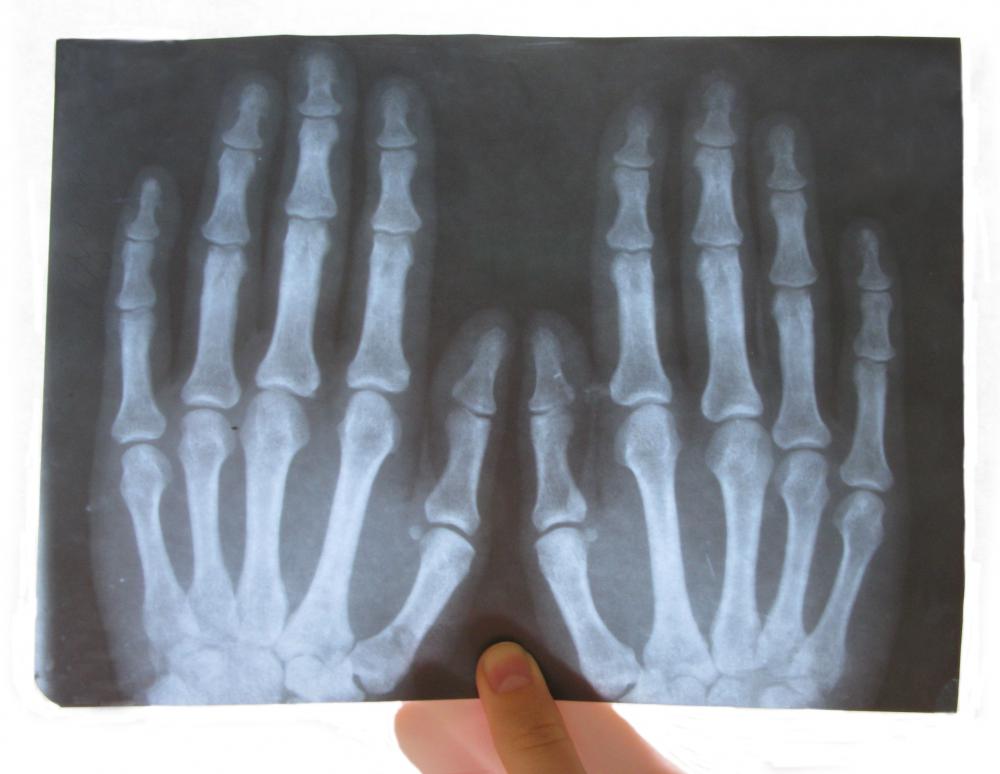At TheHealthBoard, we're committed to delivering accurate, trustworthy information. Our expert-authored content is rigorously fact-checked and sourced from credible authorities. Discover how we uphold the highest standards in providing you with reliable knowledge.
What is the Knuckle Joint?
The knuckle joint is the joint in the hand where the finger connects to the hand, or, more formally, where one of the proximal phalanx bones articulates with the corresponding metacarpal bone. Similar joints can also be found on the feet, and people often refer to the joints between individual phalanx bones in the fingers as knuckles as well. The distinctive bulgy appearance of the knuckles is caused by the shape of the bone, with the bones having rounded protuberances which are designed to facilitate articulation so that the bones can move more smoothly.
The knuckles where the fingers join the hand are especially prominent, particularly when people make a fist. In fact, the appearance of the knuckle joint is even referenced in the slang term “knuckle sandwich” for a punch delivered to the mouth. Some people also have large joints between their fingers, depending on their anatomy, age, and type of work that they do.

A swollen knuckle joint is a common problem for many people. The hands see a great deal of hard use, and the joints can become inflamed and swollen in response to temperature extremes, exposure to chemicals, repeated hard work, repetitive motion, and many other factors. The knuckle joint also becomes swollen in people with arthritis, and sometimes the joints are twisted, as well, making it difficult for people to use their hands.

One especially common problem with swollen knuckles is the trapping of jewelry, especially in men. Men who never remove their wedding rings may find that the rings are actually impossible to remove due to swelling in the knuckle, and in some cases rings need to be cut off in emergencies because there is no way to slide the ring over the joint. In non-emergency situations, people can try icing the joint to bring the swelling down, or lubricating the joint with soap to see if this will encourage the ring to slide off.

The knuckle joint is also famous for the distinctive popping or crackling sound made when the joint is flexed. Knuckles can pop naturally with certain kinds of movement, and people can also crack their knuckles deliberately by putting stress on the joint. The crackling happens because stretching the joint lowers the pressure inside, allowing dissolved gases to precipitate out as bubbles, and the bubbles pop as the pressure drops. Since the pressure takes a moment to equalize after the joint is relaxed, it is usually not possible to pop the knuckles right after they have been popped.
AS FEATURED ON:
AS FEATURED ON:
















Discussion Comments
We go camping in the mountains every year and by the time the week is over, most of us have swollen knuckle joints.
It must be something to do with the altitude that causes this. I don't usually have any trouble removing my rings, but am not able to do this for a few days after I return home from the mountains.
This is something that happens every year and happens to almost every one in our group. Many people not only have swollen knuckles, but ankles and feet as well.
My sister in law has rheumatoid arthritis and has very large and swollen knuckles. It almost looks like she has small bumps on top of her knuckles.
I know these can also be quite painful for her, and does limit what she can do with her hands. You wouldn't think that a knuckle joint would be that big of a deal, but if several of your joints are swollen and tender, it can really hinder your activity.
She is not able to remove her ring because her knuckle joints stay so swollen.
I have always had the bad habit of cracking my knuckles. As a kid, my sister would always tell me that my knuckles would get too big and that I should stop.
Since I never listened to what my sister told me, I kept right on cracking my knuckles and still find myself doing this today. It is something that I don't even think about because it has become so common for me.
Whenever I come across an article or see something on the news about people who crack their knuckles, I always listen to see what they have to say.
Most things I have heard say that you aren't doing any damage and it won't cause your knuckles to become too large. I can wear the same size ring that I wore when I was younger, and have no trouble removing my rings, so figure it has not done me any harm.
Post your comments